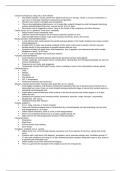Cold Sores herpes (to creep GK.): fever blisters
Oral herpes simplex I viruses cause fever blisters that recur on the lips, mouth, or mucous membranes. It
can occur on any body membrane (conjunctiva and genitals).
Infection may result in meningitis and encephalitis.
There is burning/tingling (initial lesions 1 to 2 week after contact) followed by small red papules becoming
vesicles (painful blisters) that crust. Lesions last for 10 to 21 days.
Recurrence can be triggered by stress, injury to the mouth or lips, pregnancy and other illnesses.
Canker Sores: A.K.A. aphthous "small ulcer" stomatitis
Painful mouth-mucus membrane ulcer.
Unknown cause but thought to be an immune response reaction or virus.
Other possible factors include rough tooth brushing, acid foods, stress, and viruses.
Mumps parotitis: near/ear/inflammation
A viral infection that mainly attacks the parotid (salivary) glands in the cheeks leading to the classic swollen-
cheek appearance.
Roughly 33% of males may develop unilateral orchitis which could result in sterility. Women may also
develop sterility if they experience a gonadal infection with the virus.
Symptoms include low-grade fever, mild headaches, loss of appetite, and abdominal pain which usually
disappear in about 7 to 10 days.
A form of viral meningitis may result from infection.
Par/ot/itis near/ear/inflamed
Acute infectious viral febrile disease affecting the parotid (near/ear) saliva glands.
Orchitis, oophoritis, and mastitis may be complications. Hearing loss and meningo/encephalitis are rare but
serious complications.
Treatment is rest, fluids, and analgesics.
Occasionally mumps (Old English: bump, lump or swelling) is seen in the sub/maxill/ary salivary glands.
Characterized by
Chills
Malaise
Headache
Pain below ear
102 °F temperature
Painful and restrictive jaw movement
Measles: maselen (rash Dutch); measles (skin spots ME.) A.K.A. rubeola
Acute highly contagious viral disease involving the respiratory tract due to paramyxovirus infection that is
transmitted from nose, throat, or mouth droplets during pro/drom/al stage or interval from earliest signs to a
spreading maculo/papular rash.
Koplik spots (small red with blue-white centers) on the buccal mucosa near molars appear 1 or 2 days
before the rash.
Symptoms are gradual onset showing rhin/itis, drowsiness, anorexia, cough, red eyes, conjunctivitis,
photophobia, and coryza.
Lifelong immunity after infection.
Rubella: reddish Lt.
A.K.A. 3 day, German, or French measles
Acute viral infectious disease that is characterized by a maculo/papular red rash extending over the body
and disappearing in 2 to 3 days.
Unlike rubeola (measles), there is a lack of skin desquamation.
There is an incubation period of 12 to 23 days (usually around 14).
Major concern for early pregnancies because of fetal anomalies.
Characterized by
Drowsiness
Slight fever
Cervical lymph node swelling
Sore Throat
Small/pox: small/pits (A.K.A. variola)
Highly acute viral, communicable disease caused by one of two species of pox/virus: variola and variola
minor.
Presents with a high fever (105 degrees), prostration, and a vesicular pustular rash. Incubation period is 7-
17 days with symptoms occurring in 2-3 days followed by blister eruptions filling with lymph or pus, that turn
to pustules that eventually crust.
Death usually occurs from internal hemorrhaging.
There is a government stockpile of the smallpox vaccine for emergencies.
, Chicken/pox: chicken-like: pits or pustules (A.K.A. varicella)
Acute viral disease with vesicular eruptions caused by the herpes zoster virus, which is most contagious in
winter and spring.
Lesions progress over the course of the infection. It starts with papules that develop into pustules that crust
over.
Secondary infections by staphylococcus aureus bacteria can cause septicemia, severe ulceration and
cellulitis.
Shingles: cingulus (a girdle Lt.)
The herpes zoster virus causes shingles.
When the environment is conducive, it multiplies and follows the spinal nerve on one side of body, spreading
laterally in dermatomes.
Lesions start at nerve ganglion near the spine where the virus lives.
Treatment is analgesics and lesion drying agents.
Anthrax: coal or carbuncle Gk.
An acute infection caused by Bacillus anthracis. There is a cutaneous form (direct contact) and pulmonary
form (inhaling spores).
Pustules are called anthrax boils.
May result in cyanosis, shock, coma, or death.
Pulmonary form causes
Edema
Lymph node necrosis
Pleural effusion
Internal hemorrhaging
Muscle pain
Headache
Fever
Nausea
Vomiting
Respiratory distress
Furuncul/o/sis: boil
An acute skin disease characterized by boils or successive Staphylococcus aureus infection.
Acute phlegmon/ous inflammation of the skin ending in suppuration (pus) and necrosis (tissue death).
Usually begins in hair follicle and produces pus around hair shaft.
Skin becomes smooth, shiny, and tender, progressing to later pain.
Carbuncle: small glowing ember Lt.
Most commonly a Staphylococcus aureus infection of large skin areas like the of back of the neck and
buttocks.
Causes pus (suppuration or pyo/poiesis pockets to develop deep in interconnecting subcutaneous tissues.
Sloughing necrotic or ulcerative tissue eventually discharges out of reddened skin.
It causes fever, leucocytosis, and prostration.
Treatment is antibiotics, hot compresses, and surgical drainage.
Acni/form Follicul/itis pointed/shape: tube/inflamed
Small secretory sacs or cavities that are inflamed and resembles acne.
Seen between 20 and 40 years of age.
Sebaceous glands around a hair or hair follicle atrophy and this leads to baldness.
Believed to be caused by staphylococcus bacteria.
Par/onych/ia: near/nail (A.K.A ingrown nail, felon, whitlow, panaris, runaround)
Acute or chronic inflammation of the nail margin often caused by trauma and bacterial or fungal infections.
Characterized by redness, swelling, and pus production around nail edge.
A whitlow is an inflammation of a finger or toe, at or near the end.
In M/E it means white flow."
A felon has a suppurative abscess at the end of joint of a finger toe. In Scandinavian the term "felon" means
a nail that has a crack and flaw.
Impetigo: impetere means to attack in Lt.
Acute inflammatory skin disease that causes circinate (ring-like), bulbous (bulb-like) and gyrate (circular)
lesions due to infection with Staphylococcus aureus and/or streptococcus bacteria.
Crusted pustules (pus filled) vesiculation (blisters) that rupture spreading the bacteria in a straw-colored
fluid, which dries up and forms honey-colored crusts.
Usually seen in children, but it can also occur in adults that are continuously exposed to moisture or heat.
Pyo/derma Gangrenosa: pus/skin putrefaction
An acute, inflammatory, purulent, form of bacterial dermatitis.




